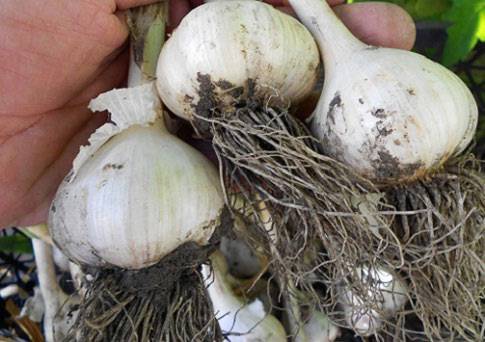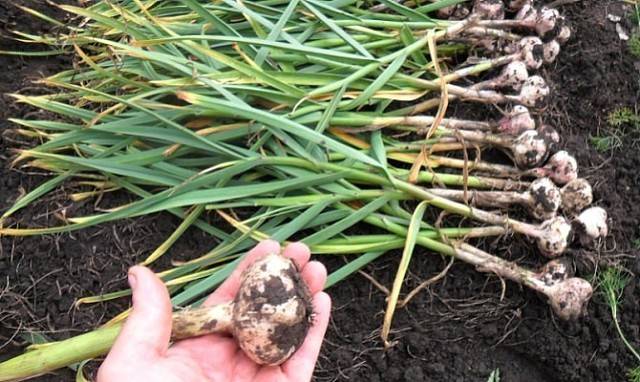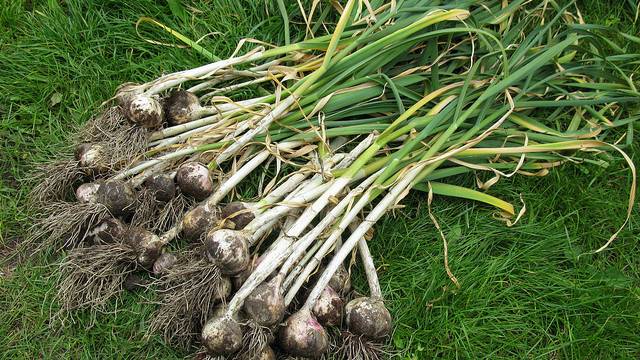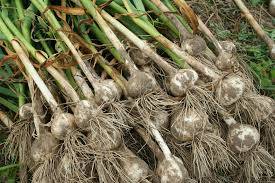Some of their garlic varieties are successfully grown in the cool climate of the Siberian region. This takes into account the requirements for soil processing and subsequent plant care. To determine the optimal time when it is possible to harvest garlic in Siberia, the peculiarities of cultivation are taken into account, depending on weather conditions and the timing of its ripening.
Cultivars for cool climates
For planting on Siberian soil, varieties are selected with increased resistance to disease and cold. The following varieties of garlic have good indicators of development and productivity in this region:
- "Siberian"... It is often planted in this region. In shape, the bulbs of this variety are round-flat, with a slight pointed upward, weighing from 19 to 28 g. The upper scales are with a grayish-violet tinge. If the plants were planted in the fall, then the first shoots appear in March. Each bulb has an average of 4 mauve cloves.
- Garlic variety "Novosibirsk 1" characterized by increased resistance to winter cold. The bulbs reach an average of 19 g. Their shape is almost round, with an upper layer of pale pink scales. In one onion, there are up to 10 cloves with a semi-sharp taste. From one square meter of area, you can get up to 1.4 kg of the crop of this variety. A positive characteristic of Novosibirskiy 1 garlic is its resistance to fusarium.
- Semi-sharp grade "Alcor" refers to a winter species with a high yield. It is grown both on personal plots and on an industrial scale. Up to 3.6 tons of garlic are harvested from one hectare. Alcor bulbs can grow up to 36 g. Each contains up to 5 cloves. Differs in good keeping quality and disease resistance.
- Siberian variety "Scythian" ripens 95 days after planting. Bulbs weighing up to 29 g. Up to 0.8 kg of bulbs can be harvested from one square meter. The scales are quite dense with a white-lilac tint. It successfully resists bacteriosis and white rot.
- In a mid-season variety "Sir-10" flat-round shape of the bulb, weighing up to 30 g. Each consists of 9 medium-density prongs. The variety has increased winter hardiness and the ability to withstand diseases. A popular variety for use in conservation. The taste is quite spicy. "Sir-10" is poorly resistant to bacterial rot. The growing season is approximately 87 days. 0.43 kg of garlic is harvested from one square meter.
- Variety "Autumn" - universal. The bulbs are large, weighing up to 41 g. The scales are purple, and the teeth are creamy. The bulb has 4 cloves. This variety is considered early maturing. Possesses good winter hardiness and high productivity. In regions of Siberia, planting is practiced after harvesting winter crops at the beginning of the summer season.
- Variety "Bashkir-85" with a flat-round fruit shape. The bulbs are very large, weighing up to 70 g. Resistant to diseases. It is usually grown commercially. Up to 70 tons can be harvested from one hectare. To determine when this garlic can be harvested in Siberia, the day of germination is noted, since it reaches technical ripeness 90 days after this moment.
- Garlic "Grodekovsky" it has good winter hardiness, but low yield. It is possible to collect only 3 tons from 1 hectare. The growing season is about 85 days.
- Variety "Reliable" tolerates frosty months well. He has an average maturity. The bulbs are large, 70 g each. This variety has a very good keeping quality, can be stored for up to 11 months.
Planting technology
To determine the required time for planting winter garlic in Siberia, take into account the need for its rooting before the onset of cold days. The optimal period for planting is from late September to early October, and about 45 days remain until frost. If planted at an earlier date, then leaf germination and a decrease in the plant's resistance to winter temperatures are possible.
Planting winter garlic with bulbs growing at the ends of the arrows is carried out before winter, and the next year they are not dug out, but allowed to winter in the soil again. Only a year later, a fully formed garlic with several cloves or onions consisting of one large head is obtained. This type of garlic planting is the most popular in Siberia.
Harvesting garlic
It is wrong to believe that time does not matter, When to harvest winter garlic in Siberia. It is unforgivable to do this ahead of schedule or just a week later. Being in the ground for an extra couple of days can negatively affect keeping quality. The main condition is for the vegetable to be fully ripe. You must be able to determine when to start digging. The excess time spent in the soil of the heads leads to the fact that the bulb begins to disintegrate, and the scales easily peel off.
For the cathedral of garlic, planted before winter in the Siberian region, the second half of July is considered the optimal date. At this time, the seed box opens at the ends of the arrows.
Spring garlic is planted in Siberia from the second half of April to May. Unlike winter varieties, they do not shoot arrows. Spring garlic is stored better than the one planted in autumn.
For faster germination, garlic is soaked in a solution of potassium permanganate, wrapped in a cloth moistened with water and placed in the refrigerator for 2-3 days.
Time to dig spring garlic usually falls on 2 weeks after the start of the collection of winter varieties. This occurs from the first half of August and can continue until September 15th. The term varies depending on the growing season of the variety (100-125 days), the time of planting them in the ground, as well as weather conditions and care during cultivation. Prolonged heat leads to the fact that the harvest is carried out earlier than usual.
Signal when to dig out winter garlic in Siberia, the formation of cracks in the ground in the garden bed can serve. The dug out bulbs must be removed under a canopy to dry for a period of 2 weeks, after which the stump is cut off to 2-3 cm.
It is not always advisable to pick the arrows off the garlic. Some of the varieties do not respond well to this procedure, and after removing the arrow, the bulbs stop gaining weight. The varieties of garlic brought to the Siberian region from Asia do not tolerate this procedure well, but in local varieties, after the arrow breaks off, the bulb gains from 10 to 15% of the weight.
The period when you should dig up garlic planted in spring is determined by its appearance. This period usually occurs from the last week of August to September 10. By this time, the leaves acquire a yellow color, and the neck of the false stem softens. When dug up, the bulb must be firm, fully formed and free from damage.
You can focus on the lunar calendar or the weather. Cleaning should only be done in dry weather. The bulbs are dug up with a pitchfork and remain in the garden until they dry.
If the weather is very sultry or it is raining, then the crop is brought under a canopy to dry it. This process is very important for storing crops. To make it easier to preserve the garlic, its roots are shortened, leaving 2 cm each, and 7-8 cm are left from the stem, so that you can braid or tie the bulbs in a bundle and hang the bunch to the wall.
Storing garlic
After the garlic has been dug out, 2 methods are used to preserve it in the winter: warm and cold. For thermal storage, garlic is laid out in fabric bags or cardboard boxes, and placed in a dark place with a cool temperature. Use space for cold storage in the fridge or a cellar, where the temperature is not higher than +5 degrees.
Sometimes these two methods are combined. In this case, after six months of storage in a warm room, the garlic is lowered into the basement or put in the refrigerator for 2 months. This stimulates the growth of the planting material after it has been planted in the soil.












